2005 GMC SIERRA DENALI power steering fluid
[x] Cancel search: power steering fluidPage 273 of 428
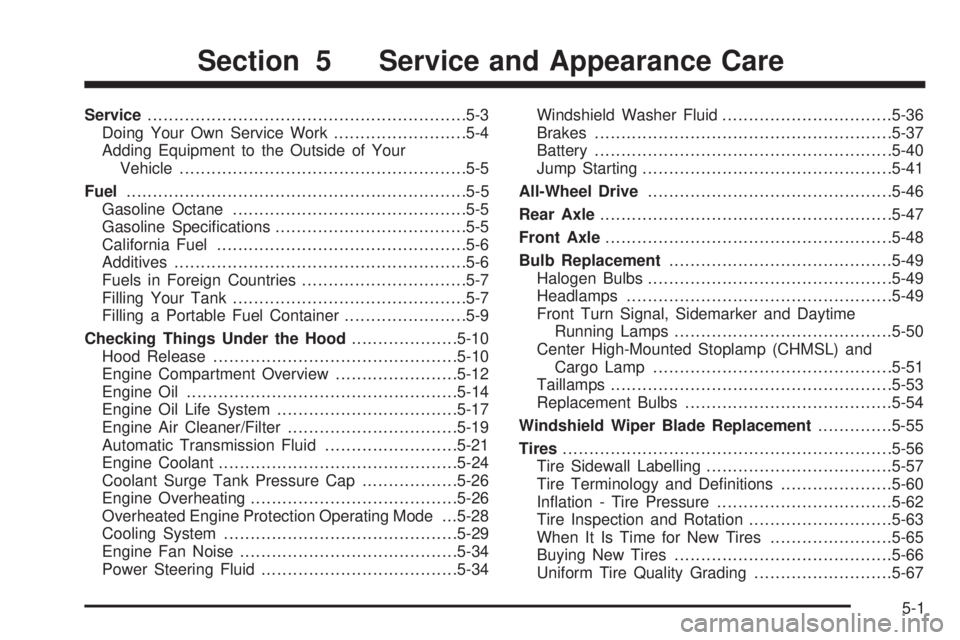
Service............................................................5-3
Doing Your Own Service Work.........................5-4
Adding Equipment to the Outside of Your
Vehicle......................................................5-5
Fuel................................................................5-5
Gasoline Octane............................................5-5
Gasoline Speci�cations....................................5-5
California Fuel...............................................5-6
Additives.......................................................5-6
Fuels in Foreign Countries...............................5-7
Filling Your Tank............................................5-7
Filling a Portable Fuel Container.......................5-9
Checking Things Under the Hood....................5-10
Hood Release..............................................5-10
Engine Compartment Overview.......................5-12
Engine Oil...................................................5-14
Engine Oil Life System..................................5-17
Engine Air Cleaner/Filter................................5-19
Automatic Transmission Fluid.........................5-21
Engine Coolant.............................................5-24
Coolant Surge Tank Pressure Cap..................5-26
Engine Overheating.......................................5-26
Overheated Engine Protection Operating Mode . . .5-28
Cooling System............................................5-29
Engine Fan Noise.........................................5-34
Power Steering Fluid.....................................5-34Windshield Washer Fluid................................5-36
Brakes........................................................5-37
Battery........................................................5-40
Jump Starting...............................................5-41
All-Wheel Drive..............................................5-46
Rear Axle.......................................................5-47
Front Axle......................................................5-48
Bulb Replacement..........................................5-49
Halogen Bulbs..............................................5-49
Headlamps..................................................5-49
Front Turn Signal, Sidemarker and Daytime
Running Lamps.........................................5-50
Center High-Mounted Stoplamp (CHMSL) and
Cargo Lamp.............................................5-51
Taillamps.....................................................5-53
Replacement Bulbs.......................................5-54
Windshield Wiper Blade Replacement..............5-55
Tires..............................................................5-56
Tire Sidewall Labelling...................................5-57
Tire Terminology and De�nitions.....................5-60
In�ation - Tire Pressure.................................5-62
Tire Inspection and Rotation...........................5-63
When It Is Time for New Tires.......................5-65
Buying New Tires.........................................5-66
Uniform Tire Quality Grading..........................5-67
Section 5 Service and Appearance Care
5-1
Page 285 of 428
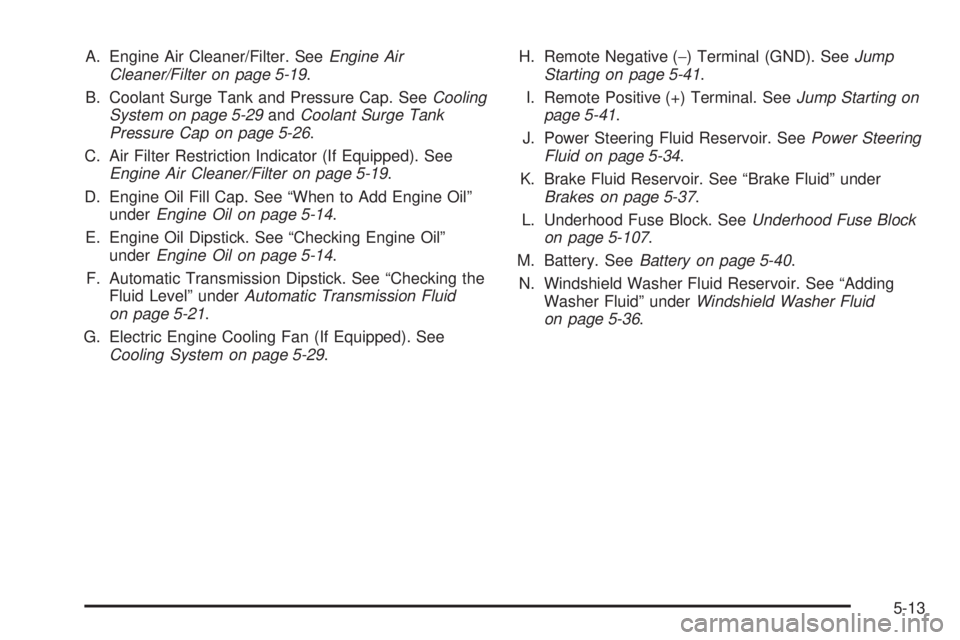
A. Engine Air Cleaner/Filter. SeeEngine Air
Cleaner/Filter on page 5-19.
B. Coolant Surge Tank and Pressure Cap. SeeCooling
System on page 5-29andCoolant Surge Tank
Pressure Cap on page 5-26.
C. Air Filter Restriction Indicator (If Equipped). See
Engine Air Cleaner/Filter on page 5-19.
D. Engine Oil Fill Cap. See “When to Add Engine Oil”
underEngine Oil on page 5-14.
E. Engine Oil Dipstick. See “Checking Engine Oil”
underEngine Oil on page 5-14.
F. Automatic Transmission Dipstick. See “Checking the
Fluid Level” underAutomatic Transmission Fluid
on page 5-21.
G. Electric Engine Cooling Fan (If Equipped). See
Cooling System on page 5-29.H. Remote Negative (−) Terminal (GND). SeeJump
Starting on page 5-41.
I. Remote Positive (+) Terminal. SeeJump Starting on
page 5-41.
J. Power Steering Fluid Reservoir. SeePower Steering
Fluid on page 5-34.
K. Brake Fluid Reservoir. See “Brake Fluid” under
Brakes on page 5-37.
L. Underhood Fuse Block. SeeUnderhood Fuse Block
on page 5-107.
M. Battery. SeeBattery on page 5-40.
N. Windshield Washer Fluid Reservoir. See “Adding
Washer Fluid” underWindshield Washer Fluid
on page 5-36.
5-13
Page 306 of 428
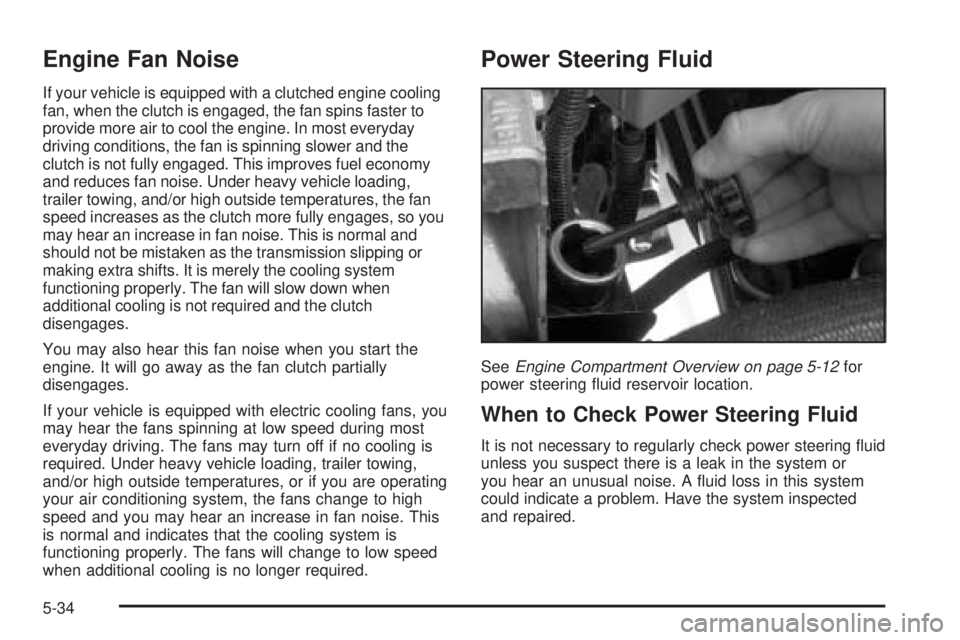
Engine Fan Noise
If your vehicle is equipped with a clutched engine cooling
fan, when the clutch is engaged, the fan spins faster to
provide more air to cool the engine. In most everyday
driving conditions, the fan is spinning slower and the
clutch is not fully engaged. This improves fuel economy
and reduces fan noise. Under heavy vehicle loading,
trailer towing, and/or high outside temperatures, the fan
speed increases as the clutch more fully engages, so you
may hear an increase in fan noise. This is normal and
should not be mistaken as the transmission slipping or
making extra shifts. It is merely the cooling system
functioning properly. The fan will slow down when
additional cooling is not required and the clutch
disengages.
You may also hear this fan noise when you start the
engine. It will go away as the fan clutch partially
disengages.
If your vehicle is equipped with electric cooling fans, you
may hear the fans spinning at low speed during most
everyday driving. The fans may turn off if no cooling is
required. Under heavy vehicle loading, trailer towing,
and/or high outside temperatures, or if you are operating
your air conditioning system, the fans change to high
speed and you may hear an increase in fan noise. This
is normal and indicates that the cooling system is
functioning properly. The fans will change to low speed
when additional cooling is no longer required.
Power Steering Fluid
SeeEngine Compartment Overview on page 5-12for
power steering �uid reservoir location.
When to Check Power Steering Fluid
It is not necessary to regularly check power steering �uid
unless you suspect there is a leak in the system or
you hear an unusual noise. A �uid loss in this system
could indicate a problem. Have the system inspected
and repaired.
5-34
Page 307 of 428
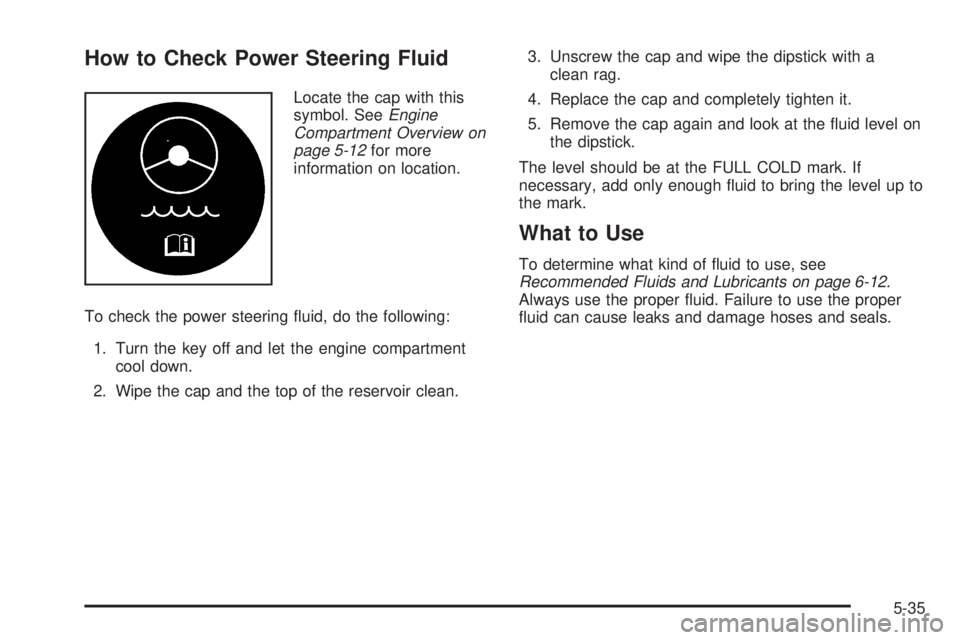
How to Check Power Steering Fluid
Locate the cap with this
symbol. SeeEngine
Compartment Overview on
page 5-12for more
information on location.
To check the power steering �uid, do the following:
1. Turn the key off and let the engine compartment
cool down.
2. Wipe the cap and the top of the reservoir clean.3. Unscrew the cap and wipe the dipstick with a
clean rag.
4. Replace the cap and completely tighten it.
5. Remove the cap again and look at the �uid level on
the dipstick.
The level should be at the FULL COLD mark. If
necessary, add only enough �uid to bring the level up to
the mark.
What to Use
To determine what kind of �uid to use, see
Recommended Fluids and Lubricants on page 6-12.
Always use the proper �uid. Failure to use the proper
�uid can cause leaks and damage hoses and seals.
5-35
Page 396 of 428
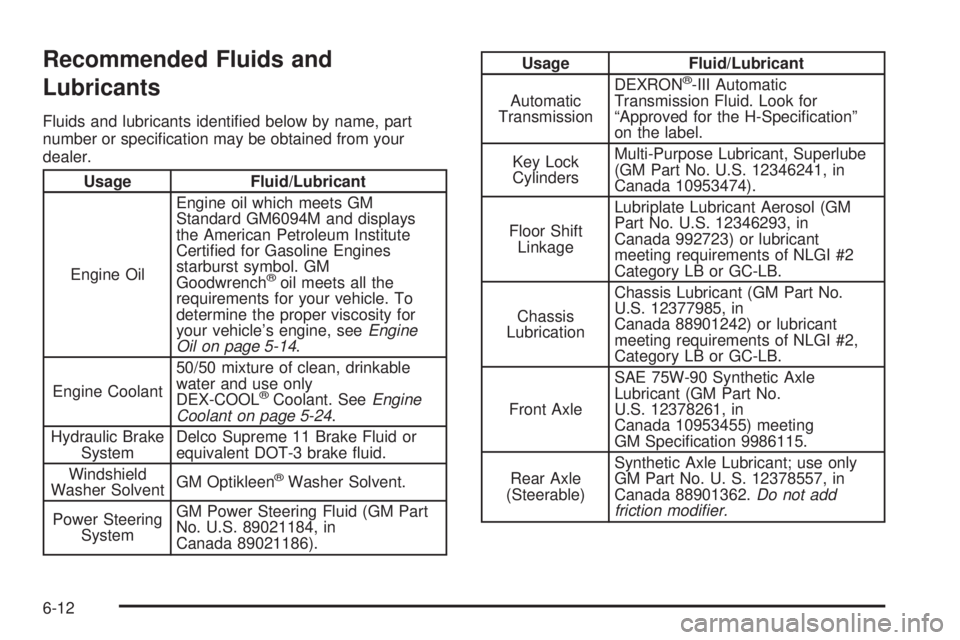
Recommended Fluids and
Lubricants
Fluids and lubricants identi�ed below by name, part
number or speci�cation may be obtained from your
dealer.
Usage Fluid/Lubricant
Engine OilEngine oil which meets GM
Standard GM6094M and displays
the American Petroleum Institute
Certi�ed for Gasoline Engines
starburst symbol. GM
Goodwrench
®oil meets all the
requirements for your vehicle. To
determine the proper viscosity for
your vehicle’s engine, seeEngine
Oil on page 5-14.
Engine Coolant50/50 mixture of clean, drinkable
water and use only
DEX-COOL
®Coolant. SeeEngine
Coolant on page 5-24.
Hydraulic Brake
SystemDelco Supreme 11 Brake Fluid or
equivalent DOT-3 brake �uid.
Windshield
Washer SolventGM Optikleen
®Washer Solvent.
Power Steering
SystemGM Power Steering Fluid (GM Part
No. U.S. 89021184, in
Canada 89021186).
Usage Fluid/Lubricant
Automatic
TransmissionDEXRON®-III Automatic
Transmission Fluid. Look for
“Approved for the H-Speci�cation”
on the label.
Key Lock
CylindersMulti-Purpose Lubricant, Superlube
(GM Part No. U.S. 12346241, in
Canada 10953474).
Floor Shift
LinkageLubriplate Lubricant Aerosol (GM
Part No. U.S. 12346293, in
Canada 992723) or lubricant
meeting requirements of NLGI #2
Category LB or GC-LB.
Chassis
LubricationChassis Lubricant (GM Part No.
U.S. 12377985, in
Canada 88901242) or lubricant
meeting requirements of NLGI #2,
Category LB or GC-LB.
Front AxleSAE 75W-90 Synthetic Axle
Lubricant (GM Part No.
U.S. 12378261, in
Canada 10953455) meeting
GM Speci�cation 9986115.
Rear Axle
(Steerable)Synthetic Axle Lubricant; use only
GM Part No. U. S. 12378557, in
Canada 88901362.Do not add
friction modi�er.
6-12
Page 419 of 428
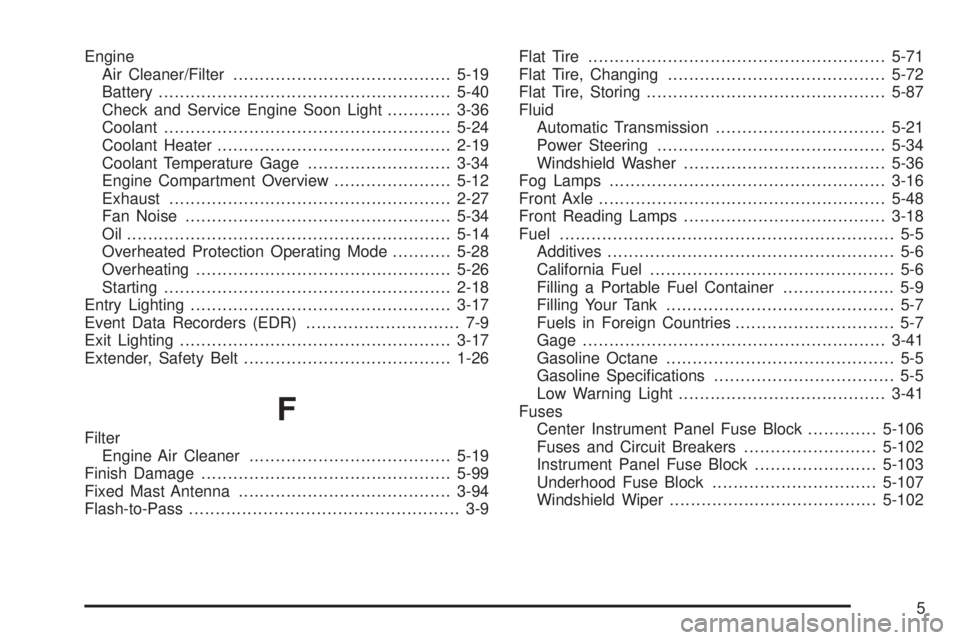
Engine
Air Cleaner/Filter.........................................5-19
Battery.......................................................5-40
Check and Service Engine Soon Light............3-36
Coolant......................................................5-24
Coolant Heater............................................2-19
Coolant Temperature Gage...........................3-34
Engine Compartment Overview......................5-12
Exhaust.....................................................2-27
Fan Noise..................................................5-34
Oil .............................................................5-14
Overheated Protection Operating Mode...........5-28
Overheating................................................5-26
Starting......................................................2-18
Entry Lighting.................................................3-17
Event Data Recorders (EDR)............................. 7-9
Exit Lighting...................................................3-17
Extender, Safety Belt.......................................1-26
F
Filter
Engine Air Cleaner......................................5-19
Finish Damage...............................................5-99
Fixed Mast Antenna........................................3-94
Flash-to-Pass................................................... 3-9Flat Tire........................................................5-71
Flat Tire, Changing.........................................5-72
Flat Tire, Storing.............................................5-87
Fluid
Automatic Transmission................................5-21
Power Steering...........................................5-34
Windshield Washer......................................5-36
Fog Lamps....................................................3-16
Front Axle......................................................5-48
Front Reading Lamps......................................3-18
Fuel............................................................... 5-5
Additives...................................................... 5-6
California Fuel.............................................. 5-6
Filling a Portable Fuel Container..................... 5-9
Filling Your Tank........................................... 5-7
Fuels in Foreign Countries.............................. 5-7
Gage.........................................................3-41
Gasoline Octane........................................... 5-5
Gasoline Speci�cations.................................. 5-5
Low Warning Light.......................................3-41
Fuses
Center Instrument Panel Fuse Block.............5-106
Fuses and Circuit Breakers.........................5-102
Instrument Panel Fuse Block.......................5-103
Underhood Fuse Block...............................5-107
Windshield Wiper.......................................5-102
5
Page 423 of 428
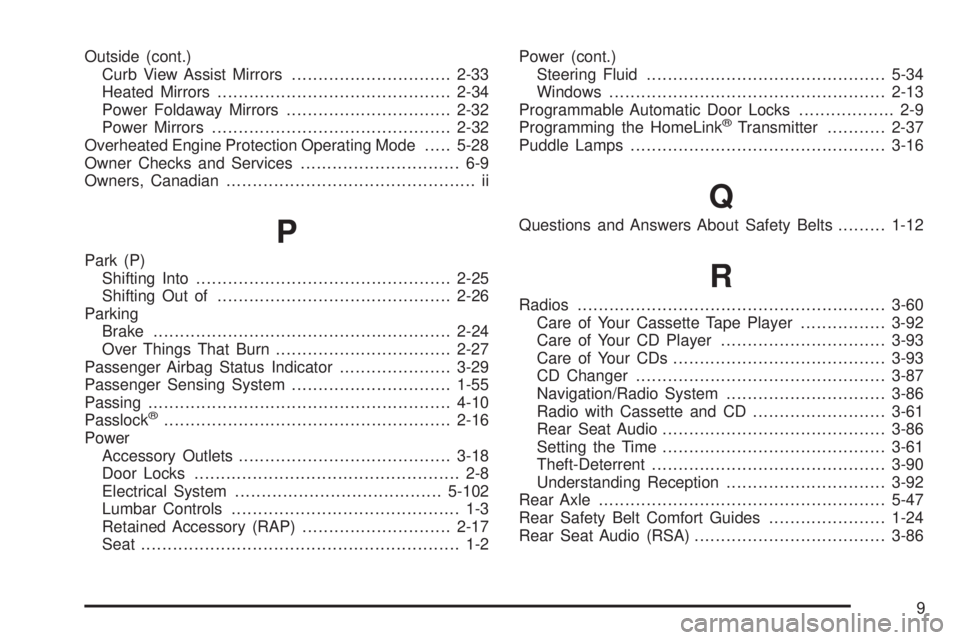
Outside (cont.)
Curb View Assist Mirrors..............................2-33
Heated Mirrors............................................2-34
Power Foldaway Mirrors...............................2-32
Power Mirrors.............................................2-32
Overheated Engine Protection Operating Mode.....5-28
Owner Checks and Services.............................. 6-9
Owners, Canadian............................................... ii
P
Park (P)
Shifting Into................................................2-25
Shifting Out of............................................2-26
Parking
Brake........................................................2-24
Over Things That Burn.................................2-27
Passenger Airbag Status Indicator.....................3-29
Passenger Sensing System..............................1-55
Passing.........................................................4-10
Passlock
®......................................................2-16
Power
Accessory Outlets........................................3-18
Door Locks.................................................. 2-8
Electrical System.......................................5-102
Lumbar Controls........................................... 1-3
Retained Accessory (RAP)............................2-17
Seat............................................................ 1-2Power (cont.)
Steering Fluid.............................................5-34
Windows....................................................2-13
Programmable Automatic Door Locks.................. 2-9
Programming the HomeLink
®Transmitter...........2-37
Puddle Lamps................................................3-16
Q
Questions and Answers About Safety Belts.........1-12
R
Radios..........................................................3-60
Care of Your Cassette Tape Player................3-92
Care of Your CD Player...............................3-93
Care of Your CDs........................................3-93
CD Changer...............................................3-87
Navigation/Radio System..............................3-86
Radio with Cassette and CD.........................3-61
Rear Seat Audio..........................................3-86
Setting the Time..........................................3-61
Theft-Deterrent............................................3-90
Understanding Reception..............................3-92
Rear Axle......................................................5-47
Rear Safety Belt Comfort Guides......................1-24
Rear Seat Audio (RSA)....................................3-86
9